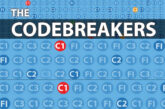
Need help with cracking those EICR codes?
The technical team at NAPIT, with the help of the 18th Edition Codebreakers publication, answer your latest coding queries.
LEE TAPPING: We manage a social housing contract and come across many concerning finds. This has to be one of the stupidest things I’ve seen in a while.
Codebreakers: I’m not quite sure what’s gone on here, but I can guess it was one of the following (poor) excuses:
- RCD is faulty and keeps tripping – so remove it,
- Circuits on one of the RCD protected sides of the high integrity board are tripping the RCD – so remove it,
- Lost the second RCD – so improvise.
At first glance, most won’t spot the issue here, so fair play to Lee’s vigilance. The area in the red circle has two 32A type B CBs, which have been used to substitute one of the RCDs in a high integrity type CU. For whatever reason this has been done, it is extremely dangerous. The circuits placed on the side with the missing RCD now have no additional protection. If the RCD was tripping because a circuit or appliance caused it to trip, and this hasn’t been investigated, the fault is likely to be there still. More dangerously, there is now a fused neutral. If the load on the modified side exceeds the 32A device in the neutral conductor, which then operates, the circuit will still be live unless the live conductor CB is isolated. This is an incredibly dangerous and foolhardy modification.

JOHNNY COOKE: I found this today during a rewire on a Chinese takeaway – lead and paper lined cable supplying the first floor sockets still in use!
When we inspect and test, we are primarily looking to comply with 651.1, to determine, so far as is reasonably practicable, whether the installation is safe for continued use. By doing this, we are evaluating work carried out to previous editions of the Wiring Regulations and comparing them with the current version of BS 7671. At some point, existing installation methods and equipment will become obsolete by either a change in our wiring techniques or the inability to repair or source spares or both.
As we can see here, we have access to live parts as the junction box (JB) lid is missing. Even if a spare could be found, the basic insulation on the conductors internal to the JB seems to show signs of degradation. We can also see live conductors have become exposed externally to the JB; just under the voltage indicator.
The means of earthing the metal sheath of the lead sheathed cable also leaves a little to be desired from a modern standpoint, and wouldn’t have been to manufacturers spec, even in its day.
Lead sheathed cables, such as these, were in use between 1920 and the late 1950’s so is likely to be 70 to 100 years old.
To be fair the most damming factor that will make this observation unsatisfactory and point towards a significant upgrade is the failure of the basic insulation on the conductors, and them not being taken into an enclosure, which is almost impossible to rectify effectively.

To find out how you can order your copy of the updated 18th Edition Codebreakers publication visit: www.napitcodebreakers.co.uk








